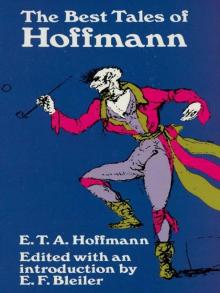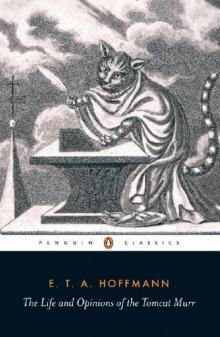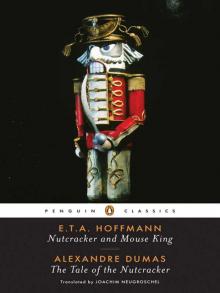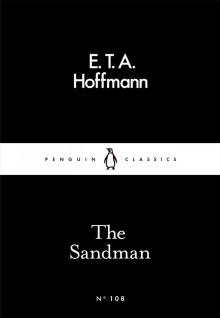- Home
- E. T. A. Hoffmann
The Life and Opinions of the Tomcat Murr
The Life and Opinions of the Tomcat Murr Read online
PENGUIN CLASSICS
THE LIFE AND OPINIONS OF THE TOMCAT MURR
E. T. A. HOFFMANN was born in Königsberg on 24 January 1776 and baptized Ernst Theodor Wilhelm Hoffmann; he later substituted Amadeus for Wilhelm out of admiration for Mozart. Having studied law, he entered the Prussian civil service and held a number of legal posts in the eastern Prussian provinces. His earliest ambition was to be a composer or a graphic artist and painter, and it was not until he was in his thirties that he turned to fiction, becoming one of the best-known and most influential authors of his time. Fantasiestücke, his earliest collection of tales, appeared in 1814. This was followed three years later by Nachtstücke and then in 1819-21 by the Serapions-Brüder. Among his longer works is his second and final novel, Lebensansichten des Katers Murr (1820–22, The Life and Opinions of the Tomcat Murr), which represents the high-point of his art. He exploited the grotesque and the bizarre in a manner unmatched by any other Romantic writer. Hoffmann died in Berlin on 25 June 1822.
ANTHEA BELL was born in Suffolk and educated at Somerville College, Oxford. She has worked as a translator for many years, primarily from German and French. Her translations include works of non-fiction (biography, politics, social history and musicology), literary and popular fiction, and numerous children’s books, including classic German works by the Grimm brothers, Clemens Brentano, Wilhelm Hauff and Christian Morgenstern. She has received many prizes and awards, including the Mildred L. Batchelder Award in 1979, 1990 and 1995; the 1987 Schlegel-Tieck Prize for Hans Bemmann’s The Stone and the Flute; and in 1996 the first Marsh Award for Children’s Literature in Translation for Christine Nöstlinger’s A Dog’s Life. Anthea Bell has also served on the committee of the Translators Association and the jury panel of the Schlegel-Tieck German translation prize in the UK. She lives in Cambridge and has two adult sons.
JEREMY ADLER is Professor of German at King’s College London. He studied German at Queen Mary College (University of London) and was a Lecturer in German at Westfield College before being awarded a Personal Chair. He is a sometime fellow of the Institute of Advanced Study, Berlin, and a sometime scholar of the Herzog August Bibliothek, Wolfenbüttel. He has written a book on Goethe’s novel The Elective Affinities (1987), produced (with Ulrich Ernst) a catalogue of visual poetry, Text als Figur (3rd edn, 1990), and edited Hölderlin’s Selected Poems and Fragments for Penguin Classics. He also wrote the biograhpy Franz Kafka for Penguin Illustrated Lives (2001). He has published several volumes of poetry, including The Wedding and other Marriages (1980), The Electric Alphabet (1986; 2nd edn, 1996, internet edn, 1997) and At the Edge of the World (1995). Jeremy Adler is married and lives in London.
THE LIFE AND OPINIONS OF
THE TOMCAT MURR
together with a fragmentary Biography of
Kapellmeister Johannes Kreisler
on Random Sheets of Waste Paper
EDITED BY E. T. A. HOFFMANN
Translated and annotated by ANTHEA BELL
with an Introduction by JEREMY ADLER
PENGUIN BOOKS
PENGUIN BOOKS
Published by the Penguin Group
Penguin Books Ltd, 80 Strand, London, WC2R 0RL, England
Penguin Putnam Inc., 375 Hudson Street, New York, New York 10014, USA
Penguin Books Australia Ltd, Ringwood, Victoria, Australia
Penguin Books Canada Ltd, 10 Alcorn Avenue, Toronto, Ontario, Canada M4V 3B2
Penguin Books (NZ) Ltd, Private Bag 102902, NSMC, Auckland, New Zealand
Penguin Books Ltd, Registered Offices: 80 Strand, London, WC2R 0RL, England
First published 1820–22
Published in Penguin Classics 1999
Translation and notes copyright © Anthea Bell, 1999
Introduction copyright © Jeremy Adler, 1999
All rights reserved
The moral right of the translator and the author of the introduction has been asserted
Except in the United States of America, this book is sold subject to the condition that it shall not, by way of trade or otherwise, be lent, re-sold, hired out, or otherwise circulated without the publisher’s prior consent in any form of binding or cover other than that in which it is published and without a similar condition including this condition being imposed on the subsequent purchaser
978-0-14-193731-1
CONTENTS
INTRODUCTION BY JEREMY ADLER
FURTHER READING
NOTE ON THE ILLUSTRATIONS
THE LIFE AND OPINIONS OF THE TOMCAT MURR
VOLUME ONE
EDITOR’S FOREWORD
AUTHOR’S PREFACE
FOREWORD
PART I Sensations of Existence
My Months of Youth
PART II My Youthful Experiences
I Too was in Arcadia
VOLUME TWO
PART III My Apprentice Months
The Whimsical Play of Chance
PART IV Beneficial Consequences of a Superior Education
My Months of Greater Maturity
EDITOR’S POSTSCRIPT
NOTES
INTRODUCTION
I
E. T. A. Hoffmann is Germany’s supreme story-teller. As such, he occupies a key place in the making of modern fiction. Others may have greater range or a better grip on social issues, but Hoffmann is unequalled in displaying the sheer joy of unbridled story-telling, with a voice that is friendly, cosmopolitan and humane. Moreover, in his hands, the strenuous ideas developed in early German Romanticism become infused into supple, fast-moving tales, peopled by a host of sharply-drawn, often comic characters. Figures like Anselmus, the clumsy student in The Golden Pot, René Cardillac, the demonic jeweller in Mademoiselle de Scudery, and the highly-strung composer, Johannes Kreisler, in The Tomcat Murr are both plausible individuals and living embodiments of Romantic ideas. With its brightly-painted characters and lively views linked by masterly plotting, the amusingly titled The Life and Opinions of the Tomcat Murr together with a Fragmentary Biography of Kapellmeister Johannes Kreisler on Random Sheets of Waste Paper shows Hoffmann at the height of his powers. His last great work, it is perhaps the most readable of all the German Romantic novels. It is certainly the funniest.
Hoffmann’s writing vividly encapsulates the romantic fascination with the individual and the imagination, with both nature and the supernatural, and with art itself, yet sets these concerns into the humdrum bustle of everyday life. There, Hoffmann explores the bizarre, the fantastic, the ridiculous and the sublime. His characters are students, officials, courtiers and bureaucrats, men and women who must toil to earn their bread, beer and tobacco. Professionals – priests, lawyers and doctors – also people his world, as do servants and market-folk. And he scrutinizes the effete German aristocracy, too, who feature so prominently in The Tomcat Murr. Against the background provided by the three chief social classes represented by servants, bourgeoisie and aristocrats Hoffmann focuses on the exceptional characters, the artists and craftsmen, who belong nowhere and suffer the agonies inflicted on them by stifling social conventions because their insight sets them apart from other mortals, confronting them with the abyss that yawns between mundane reality and the infinite. Facing these two worlds, Hoffmann revels in contradiction. Rationally, he analyses the spirit, laying bare extreme psychic states and yet, giving way to the irrational, he seems to lose himself, probing the occult phenomena that lie at the penumbra beyond empirical experience. He delights in playing with gothic horror, yet humorously uncovers the myth that lies behind the sublunary world. Throughout, Hoffmann’s narrators display such a warmth towards humanity, so welcoming an affection towards the reader, tha
t they charm and beguile us, his ‘dear readers’, endearing to us the story-teller and his tale in the very act of ensnaring us in a frequently, but by no means always, fantastic world. In thus modulating Novalis’s esoteric definition that Romanticism heightens the ordinary and concretizes the spirit (‘The world must be romanticized…’), Hoffmann renegotiated the relationship between the real and the supernatural. He handles writing as a flexible dialogue between fact and fantasy, and these are the thematic ingredients he mixes in ever-new and startling combinations. By inventing this method, and borrowing heavily from popular writing, he effectively re-wrote serious fiction’s contract with the reading public. Both urban realism and mythic fantasy achieve major formulations in his work. Hence his popularity with ordinary German readers in his day, and the distaste with which the contemporary élite, represented by Goethe, regarded him. Ironically, though, despite his dubious literary status, he was one of Germany’s most popular writers. It was also in large measure via Hoffmann that early German Romanticism’s aesthetic discoveries, notably the ideas of the Schlegel brothers, Novalis, Tieck and Wackenroder, as well as popularized versions of Romantic philosophy, based on Fichte and Schelling, reached a wider European audience. As Thomas Mann observed, writing in 1940, Hoffmann was the only nineteenth-century German writer to achieve European status.
It comes as a surprise to realize that the list of writers whom Hoffmann directly affected reads like a roll-call of nineteenth-century literature. In France, his followers include Balzac and Baudelaire. Merimée and Gautier also belong to Hoffmann’s school, as does Nerval, whose whimsical idea of walking a lobster on a lead through Paris translates a typical Hoffmannesque fantasy into life. In this way, Hoffmann’s arabesques fuelled the very real protest of later dandies and rebels. In English and American literature, both Poe and Dickens owe him a debt. Poe’s Fall of the House of Usher recalls Hoffmann’s The Entail as, indeed, does Wuthering Heights, and the imaginary megalosaurus ‘waddling like an elephantine lizard up Holborn Hill’ at the start of Bleak House bears an uncanny affinity with the mythical Salamander inhabiting contemporary Dresden in Hoffmann’s The Golden Pot. Similarly, the dual character Dr Jekyll and Mr Hyde recalls Hoffmann’s René Cardillac in Mademoiselle de Scudery, the demonic red-haired craftsman who at night exchanges his persona as the finest jeweller in Paris for that of a malignant murderer.1 Thackeray and Meredith also have their Hoffmannesque moments. In Russia, among others, Pushkin as a story-teller as well as Gogol and Dostoevsky likewise testify to Hoffmann’s influence. Both the actual crime-story (Hoffmann’s innocent lady detective, Mlle de Scudery, is an ancestor of Miss Marple) and the metaphysical crime-novel, developed in works such as Dostoevsky’s Crime and Punishment and Kafka’s The Trial, extend Hoffmann’s fascination with the darker side of life, just as their explorations of spiritual guilt intensify and deepen Hoffmann’s earlier psychological probings. Of course, Hoffmann did not invent such preoccupations, but his contribution is considerable, and often overlooked. Thus, in a fine essay on Franz Kafka, Milan Kundera credits Kafka with paving the way for modernist fiction by reinventing the imagination; but in doing this, Kafka was also revisiting Hoffmann, whose predilection for the uncanny he shares. Kafka’s painstaking realism as the scene for logically impossible events, like Gregor Samsa’s realistically represented transformation into a beetle in The Metamorphosis, harks back to the Romantic writer, who was probably the first to formulate this technique as an aesthetic tenet, his so-called ‘serapiontic principle’. Today, Italo Calvino’s narratological pyrotechnics, Garcia Marquez’s century of solitude, Mario Vargas Llosa’s effervescent scriptwriter, and Umberto Eco’s fantastical monastery all betray recognizable Hoffmannesque traits. This does not, I hasten to emphasize, indicate an actual dependence. His inventions have become so widespread that no first-hand acquaintance with Hoffmann is any longer necessary for us to fall under his spell – though not to know him is to miss one of reading’s great delights. He is the true father of magic realism.
Hoffmann’s stories and novels are a major channel through which fiction from Cervantes onwards passed into our own time. His mediations include not just German Romanticism, but, more widely, a significant style in fiction, which runs counter to the predominantly realist mode which established itself above all in the nineteenth-century novel, namely the zigzag lines of satire and whimsy – the eccentric dart that flies from Rabelais, Cervantes and Sterne.
The Tomcat Murr fully participates in this dialogue.
Looking back, in the tomcat himself we meet a feline descendant of Cervantes’ loquacious canine, the dog Berganza, duly honoured in the novel; in Murr’s artistic counterpart, Johannes Kreisler, we discern the literary fascination with a musician earlier evidenced in Diderot’s Le Neveu de Rameau; in Hoffmann’s satire on biographical method in the Kreisler story, we note the comic echoing of Tristram Shandy, recalled by the novel’s verbose title; and the cat-novel’s friskily fragmented structure recalls Enlightenment bravura pieces such as Diderot’s Le Rêve de d’Alembert and Sterne’s Sentimental Journey. The Tomcat Murr, therefore, recapitulates and varies key ideas and devices drawn from satire and comic fiction, yet at the same time invents new motifs and techniques, adopted and extended by later writers.
The novel has had an extraordinarily wide-ranging influence. Kierkegaard’s Either/Or adapts its polar structure, and Bulgakov varied the same technique in The Master and Margarita. No less a stylist than Thomas Mann turned to The Tomcat Murr when, at the height of his career, he planned his own magnum opus, Dr Faustus. Even today, Hoffmann’s cat (like Flaubert’s parrot) continues to afford literary inspiration, as can be seen in the work of the contemporary German novelist, Christa Wolf, who recently took up the tomcat’s tale.
The far-flung variety of the Hoffmannites indicates that Sainte-Beuve, in an article on Nodier, was only stating the obvious with urbane simplicity when he christened them ‘Hoffmann’s poetic family’. Belonging to the clan in the nineteenth century, one may infer, signified unconventionality, rebellion and aesthetic liberation. Sir Walter Scott, in his essay ‘On the Supernatural in Fictitious Compositions’, drew the battle-lines between convention and realism on the one hand and imaginative fiction on the other, and in so doing unwittingly fed the very appetite for Hoffmann that he sought to quell:
It is impossible to subject tales of this nature to criticism. They are not the visions of a poetical mind, they have scarcely even the seeming authenticity which the hallucinations of lunacy convey to the patient; they are the feverish dreams of a lightheaded patient, to which, though they may sometimes excite by their peculiarity, or surprise by their oddity, we never feel disposed to yield more than momentary attention. In fact, the inspirations of Hoffmann so often resemble the ideas produced by the immoderate use of opium, that we cannot help considering his case as one requiring the assistance of medicine rather than of criticism…1
To the modern eye, schooled in aesthetics after Baudelaire, Scott’s damnation reads more like an invitation, and that, at least, is to his credit. Fortunately, though, criticism has got beyond Scott, who somewhat confused the artist with his model. Most readers now prefer Hoffmann’s omnipresent wit and irony, which seem to have eluded Scott, to the sanctimonious pomposity of Scott’s critique. Today’s reader, moreover, to whom Hoffmann’s narrative self-consciousness has become second-nature, will better distinguish between madness and its representation, and will more approvingly recognize Hoffmann’s sharply-delineated portraits of derangement: his sympathetic probings invite not condemnation but empathy, as he enables us to understand our own, innermost selves via the tortured beings who exist somewhere between sanity and madness; indeed, we now know that far from having been produced by a sick mind, Hoffmann’s studies in psychic disorder, to which the characterization in The Tomcat Murr owes so much, profited from his familiarity with the latest in early nineteenth-century psychiatry. As to the narcotics and other stimulants, a more careful reader will note that far fro
m displaying the symptoms found in exclusively drug-dependent writings, works like The Golden Pot problematize such delectably psychedelic substances as tobacco, beer, wine, punch and brandy. A drawing of Kreisler done in 1822 shows him pipe-in-hand, dancing deliriously. He may – possibly – be smoking opium. But Hoffmann’s own works are enriched and not side-tracked by his psychedeclic visions, being subjected to formal control.
Later writers redrew the battle-lines laid down by Scott. Thus George Sand, whose own Le Secrétaire intime recalls The Tomcat Murr, vigorously defended Hoffmann against the recurring charge of insanity:
Never in the history of the human spirit has anyone entered more freely and more purely into the world of dream, no one has proceeded with more logic, sense and reason against the extravagances of poetic induction, no one relied less exclusively on the imagination. And yet the imagination was his element, his real world, the actual field of his thought… the nature of his writings and the inner logic of his own actions prove that his mind was completely healthy.2
If Sand underplays Hoffmann’s reliance on the imagination, her judgement on his sanity, and his work’s health, is incontrovertible.
Flaubert likewise answers Scott when, in Madame Bovary, he satirizes Scott’s fiction, to which Emma reverts in her passion. Ironically, in this passage, it is Scott’s writing, not Hoffmann’s, that is unmasked as escapist and essentially unhealthy. Emma herself experiences a typically Hoffmannesque musical ecstasy. She succumbs to ‘the thunder of the music’ and ‘let herself be lulled by the melodies: she felt a vibration pass through her whole being, as if the bows of the violins were being drawn across her own nerves…’.3 In mocking Emma’s response to music, Flaubert’s narrator at the same time archly exploits the very style which Hoffmann, famously, introduced to music-writing. This deployment of such Hoffmannesque flourishes at realism’s very core, at the moment when Flaubert is ‘exorcizing the demons of Romanticism’, indicates how thoroughly Hoffmann’s poetic family won out against Scott.

_preview.jpg) Weird Tales. Vol. I (of 2)
Weird Tales. Vol. I (of 2)_preview.jpg) Weird Tales, Vol. II (of 2)
Weird Tales, Vol. II (of 2) The Best Tales of Hoffmann
The Best Tales of Hoffmann The Life and Opinions of the Tomcat Murr
The Life and Opinions of the Tomcat Murr Nutcracker and Mouse King and The Tale of the Nutcracker
Nutcracker and Mouse King and The Tale of the Nutcracker The Sandman
The Sandman